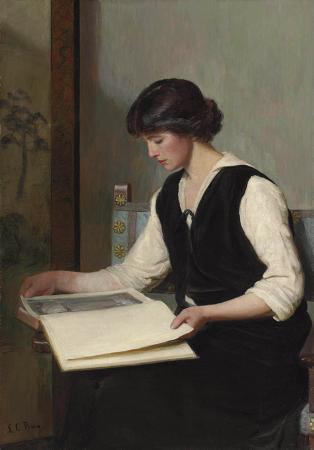Lilla Cabot Perry (1848 - 1933). Lilla Cabot Perry was an American artist who worked in the American Impressionist style, rendering portraits and landscapes in the free form manner of her mentor, Claude Monet. Perry was an early advocate of the French Impressionist style and contributed to its reception in the United States. Perry's early work was shaped by her exposure to the Boston School of artists and her travels in Europe and Japan. She was also greatly influenced by Ralph Waldo Emerson's philosophies and her friendship with Camille Pissarro. Although it was not until the age of thirty-six that Perry received formal training, her work with artists of the Impressionist, Realist, Symbolist, and German Social Realist movements greatly affected the style of her oeuvre. Lydia Cabot was born January 13, 1848 in Boston, Massachusetts. Her father was Dr. Samuel Cabot III, a distinguished surgeon. Her mother was Hannah Lowell Jackson Cabot. She was the eldest of eight children, three being, Samuel Cabot IV, chemist and founder of Valspar's Cabot Stains, Dr. Arthur Tracy Cabot, a progressive surgeon, and Godfrey Lowell Cabot, founder of Cabot Corporation. Her family was prominent in Boston society, and friends of the family included Louisa May Alcott, Ralph Waldo Emerson, and James Russell Lowell, who was her mother's cousin who respected Lilla's independent spirit, scorn of ignoble things, and alert nature. Lowell's daughter and Lilla's cousin, Mabel, was a close companion. Perry recalled having the opportunity to play the game fox and geese with both Emerson and Alcott. She had lending privileges at the Boston Atheneum, through her father, who was a proprietor, and her mother's family. Perry studied literature, language, poetry, music and had informal sketching sessions with her friends. As a child she additionally enjoyed reading books and playing sports outdoors. Perry was thirteen years old when the Civil War began. Her parents were ardent abolitionists and took an active role in the war effort by providing care to wounded soldiers and helping to protect runaway slaves. At seventeen, when the Civil War ended, Perry moved with her family to a farm in Canton, Massachusetts where much of her early interests in landscapes and nature was shaped. She traveled with her parents in 1867 to Europe, where she studied painting. On April 9, 1874, she married Thomas Sergeant Perry, a Harvard alumnus scholar and linguist. His granduncle was Matthew C. Perry, Commodore of the United States Navy. The couple had three daughters: Margaret, Edith, and Alice. She completed what is considered to be her earliest known painting, Portrait of an Infant dating from 1877-78. This work draws on the inspiration that would occupy much of her artwork throughout her career-her children. In 1884 Perry began her formal artistic training with the portrait painter Alfred Quinton Collins. Collins had studied at the Academie Julian in Paris under the guidance of Leon Bonnat. Perry's The Beginner, c. 1885-86, represents the first work she completed under formal guidance. The Beginner echoes Collins' influences with the sitter's serious gaze, dark background, and emphasis on dramatic lighting. In 1885, Perry's father died and left her an inheritance that allowed her to more seriously study art. In January 1886, she began to study with Robert Vonnoh, an artist who worked in the Impressionist's en plein air style at Grez-Sur-Loing in France. She took classes with instructor Dennis Bunker at Cowles Art School in Boston beginning in November 1886. Cowles taught its students liberal theories in the creation of realist art-theories that Perry greatly responded to. Perry was commissioned by the Waltham Watch Company to paint his three daughters.She earned sufficient money to travel first-class passage to Europe in June 1887. The Perrys moved to Paris that year. Perry enrolled in the Academie Colarossi, where she worked with Gustave Courtois and Joseph Blanc. She studied with Felix Borchardt, a German painter. In addition to receiving formal academic training, Perry spent much of her time studying the old masters in museums with Bernard Berenson, an art critic and her husband's friend. She also traveled to Spain to copy works at the Museo del Prado. Perry's The Red Hat from 1888 strongly reflects the formal training she had received and her exposure to the old masters, especially the work of Sandro Botticelli. In 1888 Perry traveled to Munich where she studied with the German social realist Fritz von Uhde. Uhde's handling of the subject and his use of color had a dynamic effect on Perry's work. By the fall of 1888 Perry had returned to Paris.
more...











